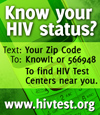HIV/AIDS 101
This message means the browser does not have the most recent version of Flash.
Download Adobe Flash Player™.
The links below will direct you to the content.
- Did you know that you can participate in important HIV vaccine research by becoming a volunteer?
- Did you know that the United States is involved in the largest international response ever for a single disease?
- Did you know that African Americans account for 49% of all new cases of HIV infection in the United States?
- Did you know that the CDC has estimated that approximately 56,300 persons in the United States become infected with HIV each year?
- Did you know that there are federal laws that protect individuals from HIV/AIDS discrimination?
- Did you know that in each year since 1991, the rate of confirmed AIDS cases has been higher among prisoners than in the general population?
- Did you know? The Veterans Administration is the largest single provider of HIV care in the United States.
- Did you know that you can be involved in the FDA review of HIV/AIDS drugs and therapies?
- Did you know that behaviors associated with drug abuse are among the main factors in the spread of HIV infection in the United States?
Facts
HIV can be found in body fluids, including:
- blood
- semen
- vaginal fluids
- breast milk
- some body fluids sometimes handled by healthcare workers (fluids surrounding the brain and spinal cord, bone joints, and around an unborn baby)
HIV is passed from one person to another by:
- having sex (vaginal, anal, or oral) with a person who has HIV
- sharing needles with a drug user who has HIV
- during pregnancy, birth, or breast-feeding if a mother has HIV
- getting a blood transfusion from a person with HIV
Abstaining from (not having) sex is the most effective way to prevent HIV transmission. There are several ways to protect yourself or to prevent transmitting HIV during vaginal, oral, or anal sex if you choose to have sex:
- Get tested for HIV and know the HIV status of yourself and your partner
- Be faithful to your sexual partner
- Use condoms or other latex barriers during vaginal, oral, and anal sex, and never reuse condoms or latex barriers
HIV cannot be transmitted by casual contact. Here are the facts:
- You cannot get HIV from shaking hands or hugging a person with HIV/AIDS
- You cannot get HIV from using a public telephone, drinking fountain, restroom, swimming pool, Jacuzzi, or hot tub
- You cannot get HIV from sharing a drink
- You cannot get HIV from being coughed or sneezed on by a person with HIV/AIDS
- You cannot get HIV from giving blood
- You cannot get HIV from a mosquito bite
Transmission of HIV while getting a tattoo or through a body piercing is possible, but it can be prevented through:
- Single-use instruments intended to penetrate the skin being used only once, then disposed of
- Reusable instruments or devices that penetrate the skin and/or contact a client's blood should be thoroughly cleaned and sterilized between clients according to medical guidelines
These guidelines are the same as those practiced within any medical facility where there is a risk of instruments coming into contact with blood.
To learn more about the facts of HIV/AIDS, please visit AIDS.gov's Overview section for additional information and a listing of resources or the Basic Information section about HIV/AIDS from the Centers for Disease Control and Prevention.





 Did you know that the CDC has estimated that approximately 56,300 persons in the United States become infected with HIV each year?
Did you know that the CDC has estimated that approximately 56,300 persons in the United States become infected with HIV each year?